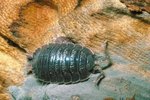
Starfish are class Asteroidea carnivores. Scientists prefer to call them sea stars. The bloodless animals are not fish; they are echinoderms. Roughly 2,000 different species of sea stars exist all around the planet. They are near kin to sea cucumbers and sea urchins.
Lots of Arms
Arms are classic and distinctive features of sea stars in general. They have radial symmetry, which means that their anatomy is based around one common meeting point, in the center. Their arms are frequently referred to as rays. Some sea stars have lengthy arms, while others have markedly short ones. Sea stars usually possess five of them, but some have up to 40. It isn't rare to see sea stars with 10 or 20 arms. Their arms appear in multiples of five. Sea stars have the ability to let go of arms in the face of predator disturbances. Their arms are able to grow back in about 12 months.
Savvy Skin
Sea stars' skin has a hardened and tough look and feel to it, which helps them defend against lots of predation. Their skin tends to be vivid in coloration, an adaptation for intimidating would-be predators. Pink, yellow and red are all common colors for sea stars. Some sea stars have skin that helps them in matching their environments, which also is beneficial for avoidance of predators.
Mouths on the Bottom
It might be tough to envision, but sea stars are indeed equipped with mouths. The headless organisms' mouths are situated on the bottoms of the circular, central portions of their physiques. Their mouths conveniently serve as pathways to their sizable stomachs.
Prickly Creatures
Sea stars' skin is not just tough, it is adorned with many spikes that are pointy and not too pleasant to the touch. Their spines serve as defense mechanisms, but they double as tools for tidying up. Sea stars employ their spines for removing persistent sand from their physiques. Spines encircle their mouths, which is helpful for keeping the smooth internal portions of their bodies secure.
Many Tube Feet
Sea stars possess large numbers of wee tube feet, which they use for motion purposes, courtesy of suction. The sluggish invertebrates' tubes begin internally and extend out to the exteriors. The majority of echinoderms in general feature tube feet. Tube feet are handy for feeding, as they assist sea stars in breaking oyster and clam meals apart.
References
Photo Credits
-
Photos.com/AbleStock.com/Getty Images




